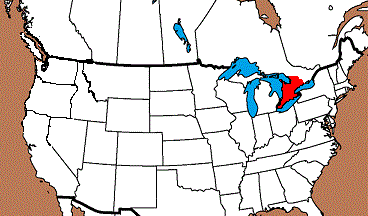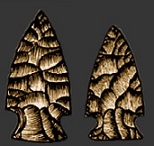Outline is Representative of Size and Shape:


Name Details:
Identified By: I. T. Kenton
Named For: Type Site
Date Identified: 1980
Type Site: Crawford Knoll Site on the St. Clair Delta, Ontario Canada
Identified By: I. T. Kenton
Named For: Type Site
Date Identified: 1980
Type Site: Crawford Knoll Site on the St. Clair Delta, Ontario Canada
Point Validity:
Valid type
This type was identified at the Crawford Knoll site and was named in a professional publication. This type has many professional references and is considered a valid type.
This type was identified at the Crawford Knoll site and was named in a professional publication. This type has many professional references and is considered a valid type.
Crawford Knoll Notched
Cluster: Description of Physical Characteristics and Flaking Pattern:
This is a small (.9 to 1.6 inches) triangular expanding stem to side notch point with an elliptical cross section which may vary to bi-triangular. The blade may vary from slightly excurvate to straight. The shoulders are horizontal, but may range from slightly barbed to having a slightly upward angle. The stem is expanding with a base that varies from slightly convex to straight with hafting region grinding commonly absent. This point has a random flaking pattern.
Size Measurements:
Length - 25 to 40 mm, Width - 15 to 20 mm, Hafting Width - 7 to 12 mm, Thickness - 4 to 8 mm.
Length - 25 to 40 mm, Width - 15 to 20 mm, Hafting Width - 7 to 12 mm, Thickness - 4 to 8 mm.
Commonly Utilized Material:
Kettle Point Chert
Kettle Point Chert
Additional Comments:
Kenyon (1980) feels that Ace of Spades, Crawford Knoll, Innes, and Hind points represent a continuum of technology and that they are variants of the same point and do not represent true unique types.
The London Chapter of the Ontario Archaeological Society posts: "At the Bruce Boyd site in Norfolk Co. (Ont. Arch. Pub. No.29) burials were associated with artifact offerings from both the Meadowood (Early Woodland ) and "Haldimand" complexes. The Haldimand points strongly resemble the Crawford Knoll specimens. There is a 520 B.C. date for the Bruce Boyd site. The presently available evidence suggests that Crawford Knoll points and related forms are characteristic of the indigenous terminal Archaic peoples of south-western Ontario. These small, notched points do not seem to be very closely related to contemporaneous cultures to the east in New York State (e.g. the Susquehanna tradition). Crawford Knoll points, however, may be related to forms used by groups in the American Midwest. The Late Archaic Riverton culture of Illinois has two point types, Merom expanding stem and Trimble side notched, which are similar in both size and shape to Crawford Knoll points. The Riverton culture sites have carbon dates which range between 1600 and 1100 B.C."
Kenyon (1980) feels that Ace of Spades, Crawford Knoll, Innes, and Hind points represent a continuum of technology and that they are variants of the same point and do not represent true unique types.
The London Chapter of the Ontario Archaeological Society posts: "At the Bruce Boyd site in Norfolk Co. (Ont. Arch. Pub. No.29) burials were associated with artifact offerings from both the Meadowood (Early Woodland ) and "Haldimand" complexes. The Haldimand points strongly resemble the Crawford Knoll specimens. There is a 520 B.C. date for the Bruce Boyd site. The presently available evidence suggests that Crawford Knoll points and related forms are characteristic of the indigenous terminal Archaic peoples of south-western Ontario. These small, notched points do not seem to be very closely related to contemporaneous cultures to the east in New York State (e.g. the Susquehanna tradition). Crawford Knoll points, however, may be related to forms used by groups in the American Midwest. The Late Archaic Riverton culture of Illinois has two point types, Merom expanding stem and Trimble side notched, which are similar in both size and shape to Crawford Knoll points. The Riverton culture sites have carbon dates which range between 1600 and 1100 B.C."
Distribution:

Distribution Comments:
This point is primarily found on the St. Clair Delta of Ontario.
This point is primarily found on the St. Clair Delta of Ontario.
Age / Periods:
Date: 3,500 - 2,500 B.P.
Cultural Period: Late to Terminal Archaic
Glacial Period: Neoglacial
Culture:
Date: 3,500 - 2,500 B.P.
Cultural Period: Late to Terminal Archaic
Glacial Period: Neoglacial
Culture:
Age Details:
The C-14 dates for the Knechtel I site in Bruce County returned dates of 1,740, 1,300, 1,090 and 938 B.C (Wright).
The C-14 dates for the Knechtel I site in Bruce County returned dates of 1,740, 1,300, 1,090 and 938 B.C (Wright).
Other points in this cluster / Related / Associated Points:


